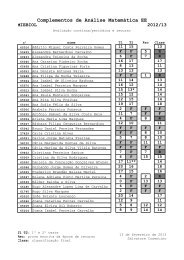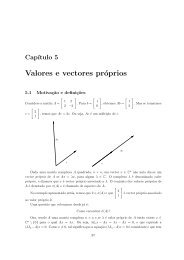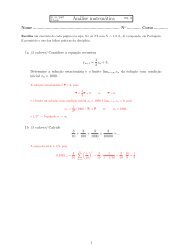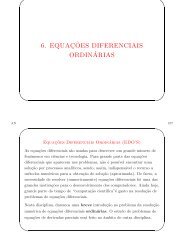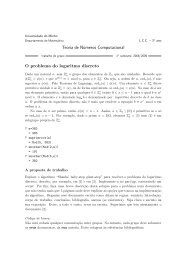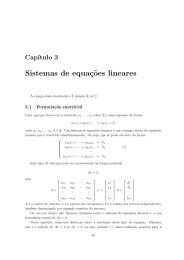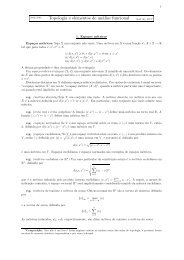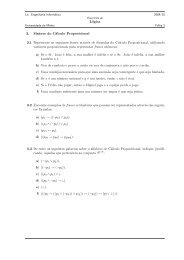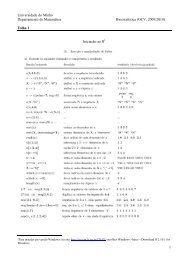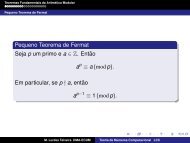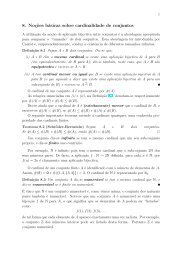My title - Departamento de Matemática da Universidade do Minho
My title - Departamento de Matemática da Universidade do Minho
My title - Departamento de Matemática da Universidade do Minho
You also want an ePaper? Increase the reach of your titles
YUMPU automatically turns print PDFs into web optimized ePapers that Google loves.
11<br />
RECORRÊNCIAS 76<br />
Poincaré recurrence theorem (topologic version). Let f : X → X be a continuous<br />
transformation of a separable metrizable topological space X. The support of any invariant Borel<br />
probability measure µ is contained in the closure of the set of recurrent points, namely<br />
supp (µ) ⊂ Rec f .<br />
If, in particular, f admits an invariant measure µ which is diffuse (i.e. gives positive measure to<br />
any nonempty open set) then the set of recurrent points is <strong>de</strong>nse in X, namely<br />
Rec f = X.<br />
Observe that if f is a homeomorphism, then the same applies to Rec f −1, and the support of<br />
any invariant Borel probability measure is contained in the closure of Rec f ∩Rec f −1.<br />
If you <strong>do</strong>n’t like the above proof, here is another, perhaps more elemenary, of the last statement.<br />
Alternative proof. Assume that the continuous map f : X → X preserves a diffuse Borel<br />
probability measure µ. For each n ≥ 1, let<br />
R n = { x ∈ X s.t. ∃ k ≥ 1 s.t. d(f k (x), x) < 1/n }<br />
be the set of ”1/n-recurrent” points. Of course, Rec f = ∩ ∞ n=1R n . The sets R n are clearly open.<br />
To show that Rec f is <strong>de</strong>nse we must show that each R n is, since then the Baire theorem implies<br />
that also their countable intersection is <strong>de</strong>nse. So, take any nonempty ball B with diameter<br />
< 1/n. Its inverse images f −1 (B), f −2 (B), f −3 (B),... have all the same measure µ(B) > 0. Since<br />
µ(X) = 1, they cannot be disjoint. There follows that there exist k > 0 and n ≥ 0 such that<br />
f −(n+k) (B) ∩ f −n (B) ≠ 0, and this implies that B contains a 1/n-recurrent point (for a point x in<br />
the intersection has both images f n (x) and f n+k (x) = f k (f n (x)) in B, hence at distance < 1/n).<br />
Since B was arbitrary, this proves that each R n is <strong>de</strong>nse, and Baire theorem implies that Rec f is<br />
<strong>de</strong>nse too.<br />
Example. Rotations of the circle preserve the Lebesgue probability measure. Hence, almost any<br />
point x + Z is recurrent for the rotation R α : x + Z ↦→ x + α + Z. If α is rational this is trivial, since<br />
all points are periodic. When α is irrational, this says that for any ε > 0 there exist an infinity of<br />
times q ∈ N that<br />
d(x + Z, x + qα + Z) < ε<br />
hence for any ε > 0, there exist an infinity of rationals p/q such that<br />
|qα − p| < ε i.e.<br />
∣ α − p q ∣ < ε q<br />
We know from continued factions that the estimate is in<strong>de</strong>ed better, since ε/q may be substituited<br />
by 1/q 2 .<br />
11.4 Conjunto não-errante<br />
Por volta <strong>do</strong>s anos trinta, George D. Birkhoff teve a i<strong>de</strong>ia <strong>de</strong> dividir o espaço <strong>do</strong>s esta<strong>do</strong>s <strong>de</strong> um<br />
sistema dinâmico em duas classes <strong>de</strong> pontos com dinâmicas qualitativamente distintas.<br />
O ponto x é errante 26 se admite uma vizinhança disjunta <strong>de</strong> to<strong>da</strong>s as suas itera<strong>da</strong>s, i.e. se<br />
existe um aberto U que contém x tal que U ∩ f n (U) = ∅ para to<strong>do</strong> tempo n ≥ 1. O ponto x não<br />
é errante se para to<strong>da</strong> vizinhança U <strong>de</strong> x existe um tempo n ≥ 1 tal que f n (U) ∩ U ≠ ∅.<br />
O conjunto não-errante NW f (<strong>do</strong> inglês “non-wan<strong>de</strong>ring set”) é o conjunto <strong>do</strong>s pontos x que não<br />
são errantes. A i<strong>de</strong>ia informal é que conjunto não-errante é on<strong>de</strong> acontece a dinâmica interessante,<br />
enquanto o conjunto errante é o conjunto <strong>do</strong>s pontos que a dinâmica esquece.<br />
26 A palavra grega por “errante”, ou seja, “vagabun<strong>do</strong>”, “que vagueia ao acaso”, era πλανητης, ou seja, planeta.



